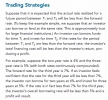alexwallace
Member
@David Harper CFA FRM ,
Dear David,
Once again, your extremely helpful insights are needed. When Eurodollar futures price changes from 94.555 to 94.715, the answer is that short contract loses $400. Now my question is: is it conceptually/logically correct to think about this case under the general umbrella of short futures position incurring a loss when the price of the underlying asset increases? That way, in this particular case price of the underlying is just the Eurodollar futures price.
By the way, what about thinking this way: price increase from 94.555 to 94.715 means rate decrease from 5.445% to 5.285% and here comes the way I suppose it should be thought about: at Eurodollar futures price of 94.555 I could have locked in a rate of 5.445%, while after decrease to 94.715 I can lock in a 5.285%, but for this to lead my thought process to a loss it must be the case that I am already locked in some initial futures price, so that subsequent favorable/unfavorable price/rate movements are causing either loss or a gain, respectively (just like in standard futures contract on other assets, like I don't know, for example, corn).
But here comes the part that has been torturing me for a long time: I am short in Eurodollar futures contract and:
* Does this mean I locked in a rate at which I can lend OR borrow? This is what I don't understand from the textbooks
** Does being long in Eurodollar futures mean I am locking in a lending or borrowing rate?
Long story short, when I am long in Eurodollar futures contract what does this mean - I need some analogy with other NON-interest-rate related futures/forwards.
If you manage to somehow explain this to my completely puzzled brain, I will be extremely thankful to You.
Dear David,
Once again, your extremely helpful insights are needed. When Eurodollar futures price changes from 94.555 to 94.715, the answer is that short contract loses $400. Now my question is: is it conceptually/logically correct to think about this case under the general umbrella of short futures position incurring a loss when the price of the underlying asset increases? That way, in this particular case price of the underlying is just the Eurodollar futures price.
By the way, what about thinking this way: price increase from 94.555 to 94.715 means rate decrease from 5.445% to 5.285% and here comes the way I suppose it should be thought about: at Eurodollar futures price of 94.555 I could have locked in a rate of 5.445%, while after decrease to 94.715 I can lock in a 5.285%, but for this to lead my thought process to a loss it must be the case that I am already locked in some initial futures price, so that subsequent favorable/unfavorable price/rate movements are causing either loss or a gain, respectively (just like in standard futures contract on other assets, like I don't know, for example, corn).
But here comes the part that has been torturing me for a long time: I am short in Eurodollar futures contract and:
* Does this mean I locked in a rate at which I can lend OR borrow? This is what I don't understand from the textbooks
** Does being long in Eurodollar futures mean I am locking in a lending or borrowing rate?
Long story short, when I am long in Eurodollar futures contract what does this mean - I need some analogy with other NON-interest-rate related futures/forwards.
If you manage to somehow explain this to my completely puzzled brain, I will be extremely thankful to You.


 )
) About your thought process and ED futures, because I have answered variations on the ED dynamic so many times (is why we beg people to search) that I specifically recorded the following two videos:
About your thought process and ED futures, because I have answered variations on the ED dynamic so many times (is why we beg people to search) that I specifically recorded the following two videos: